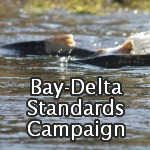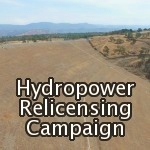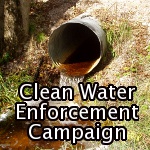The holidays are over, and the sales are on. Karla Nemeth, Director of the California Department of Water Resources (DWR) published an op-ed in CALmatters on December 26, 2018 to tell the world “what new water deals mean.” Tom Birmingham, General Manager of Westlands Water District on the west side of the San Joaquin Valley, pronounced on the same day that “new voluntary water agreements are a good deal.” Together, they’re selling a 15-year lease on the public trust resources of the Sacramento – San Joaquin watershed and the Bay-Delta estuary. Of course, like all leases, at the end of the lease period there will be no equity to show for it. As the 15 years sunset, the sales associates will throng to re-up the public on buying back public water. With luck, after those 15 years there will be some fish and other public trust resources left to protect.
On December 12, 2018, DWR Director Nemeth and Department of Fish and Wildlife (DFW) Director Chuck Bonham brought a presentation and a series of abbreviated “term sheets” for “Voluntary Settlement Agreements” to the meeting of the State Water Board. The State Water Board had agendized adoption of the update of that portion of the Bay-Delta Plan that deals with Lower San Joaquin River Flow and Southern Delta Salinity. The State Water Board adopted the Plan revisions and approved the supporting Substitute Environmental Document later that day. (See CSPA’s previous analysis here).
At the State Water Board’s December 12 meeting, Turlock and Modesto irrigation districts and the San Francisco Public Utilities Commission supported a flow agreement for the lower Tuolumne River that they had reached at least in concept with DFW. A larger group of water users supported DFW and DWR’s approach and recommended framework for Sacramento Valley flows and Delta operations. These entities even offered to draft all or part of a restructured substitute CEQA document on the State Water Board’s behalf.
So how can Mr. Birmingham unabashedly say that the new Voluntary Settlement Agreements are a “good deal” when the so many details of the agreements still need to be worked out? How can other commenters from the water user community praise the deals without really even knowing what they are? It’s because (using Mr. Birmingham’s word) these deals “preempt” a formal balancing of the public trust. They don’t start from the premise that water for the public trust is primordial and fundamentally different than water for developmental uses.
The public trust protects the needs of the rivers, the estuary and the Bay – including fish and wildlife, the aquatic food web, plants, clean water, public recreation – as first priority. Developmental uses are limited by the needs of the public trust. The State Water Board’s percent-of-unimpaired framework accepts the premise that the public trust is fundamentally different, and is first in line. CSPA’s arguments with the State Water Board are not about the Board’s framework. They are about how the State Water Board goes about drawing the line (lack of formal process for balancing the public trust) within that framework, and where the State Water Board chose to draw the line (too little water devoted to protect the public trust) within that framework.
The Voluntary Settlement Agreements are an initiative by water users, aided and abetted by the California Departments of Natural Resources and Fish and Wildlife, to substitute private agreements in place of balancing the public trust. Thus, CSPA’s argument with the Voluntary Settlement Agreements as proposed is fundamentally different than the argument with the State Water Board. CSPA’s fundamental disagreement with the Voluntary Settlements is that they place the system of water rights priority before the public trust; water for the public trust becomes the sloppy seconds of business as usual. The argument is with relegating the public trust to leftovers, not with the size or quality of the leftovers.
The framework of the Voluntary Settlement Agreements as introduced on December 12 is to limit required flows so that they don’t upset the existing divisions and allocations of water. Diverting, storing and then selling the public’s water back to “the environment” is one of the main tools of this framework. Setting up opportunities to divert “new” sources of water is another tool. Accounting tricks that increase diversions even as “new” water is released is a third. Building the Voluntary Settlement Agreements on the foundation of Water Rights Decision 1641 – a proven disaster for fish – will allow the water users another fifteen years to game a water system they have mastered.
The Voluntary Settlement Agreements are also long on selling previous commitments for non-flow measures as new commitments. Many of the non-flow actions that the listed for the Feather River are actions DWR agreed to in the Oroville Settlement Agreement for relicensing hydropower facilities at Oroville Dam. Many actions on the Sacramento have long been identified as needed. The game is not simply “will trade money for water.” It’s: will trade water for making some of the payments we’re already late in paying. The sales pitch here involves getting extra credit for actually doing something you already said you’d do.
New objectives tentatively proposed for the update of the Bay-Delta Plan, according to a July 2018 State Water Board Framework document (p. 20), would add existing Delta “reverse flow” limits to the Bay-Delta Plan. This would create a state backstop to the Trump administration, which is preparing to weaken these Endangered Species Act protections in the Delta in order to “maximize water deliveries.” Under the Voluntary Settlements, the backstop goes away. As noted in a January 4, 2019 story in the Los Angeles Times, “Department of Water Resources Director Karla Nemeth said proposed changes in [Delta] pumping operations could involve fewer restrictions and more exports.”
Adaptive management under the proposed Voluntary Settlements offers still another low-flow opportunity. Mr. Birmingham informs us: “In the eighth year of the agreements, an additional 300,000 acre-feet of water will be dedicated to Delta outflow if science establishes the additional water is required to achieve the established goals for species.” Of course, “science” won’t establish anything. People will establish the goals for the species, and people will establish the need for water. Who will those people be? “[A] collaborative group of public agencies and interested nongovernmental organizations” will “evaluate whether water used for species protection is being used reasonably and beneficially.” The “public agencies” are the state and federal contractors who spent millions of dollars over the last eight years attacking the need for more Delta outflow. They are also the federal fish agencies that didn’t utter a word in the latest round of workshops and meetings on the Bay-Delta Plan, and California DFW, whose Director showed up to cut flows in half. There is no definition of who the “interested” nongovernmental organizations might be, what their role will be, or whether they’ll have to sign and defend a lousy settlement or a non-disclosure agreement to play. With this lineup, what are the odds that conditional water will become real water?
Resource agencies, NGO’s and water users dithered for six years in secret flow negotiations on the San Joaquin, with two years of overlap with secret flow negotiations for the Sacramento Valley. In the end, a small group of water users carved up Central Valley water to meet the December 12, 2018 deadline to present agreements to the State Water Board. In Mr. Birmingham’s words: “These agreements resulted from intense negotiations among DWF [sic], DWR, the U.S. Bureau of Reclamation, public water agencies that contract for the delivery of water from the Central Valley Project and the State Water Project, and public water agencies from every upstream region in the Delta watershed.” Even though most of these entities have governance as “public water agencies,” they represent the public interest only to the degree that the public interest overlaps with the economic interests of their constituents. And none of these “public water agencies” start from the basis of the primacy of the public trust. These deciders concluded the Voluntary Settlements as private negotiations of business entities dividing up assets and liabilities. It’s a hostile takeover of the public trust.
In the negotiation of the December 12 Voluntary Settlement Agreements, two sets of entities were ostensibly negotiating to defend the public trust: DFW, which accepted the water users’ framing and framework from the start, and five hand-picked non-governmental organizations (NGO’s) that were never allowed to direct the discussion. These five NGO’s are all relatively large and well-funded national environmental organizations. But in a setting where private interests are competing, the economic and political clout of these NGO’s doesn’t hold a candle to the water users, DWR, and the Bureau of Reclamation. As undercapitalized private interests, they were marginalized; they reported to the State Water Board that most of the major discussions and negotiations took place without them, and often without them even being informed. They at least had the sense to walk away from a rigged game.
The political capital that NGO’s and resource agencies bring to processes to protect fish and other public trust resources is precisely their representation of the public interest. The five selected NGO’s signed non-disclosure agreements that cut them off from their political base and allies. They isolated themselves from the coalition of the broader NGO community, greatly limiting their resources and their strategic opportunities, and most of all weakening their moral authority immeasurably. DFW’s leadership, in conducting a secret process, grossly weakened any leverage it might have had by separating itself from the broader environmental and fishing community. It also went a long way toward breaking up working relationships that NGO’s and DFW staff have developed and strengthened over the past decade, in hydropower relicensings as well as before the State Water Board.
The State Water Board’s adoption of lower San Joaquin River flow objectives on December 12 reunited, for the moment, the broad NGO (environmental and fishing) community in favor of these objectives and against a series of lousy private deals. But the State Water Board also left the low flow Voluntary Settlement Agreements with a big foot in the door. The broad water user community has not simply initiated a parallel process to that of the State Water Board’s update the Bay-Delta Plan. The water user community is seeking to undermine the State Water Board’s process to balance the public trust. It seeks to insert a surrogate, opposing private deal dedicated to the proposition that water users should have another 15 years to siphon off the public trust and thus avoid living within their means when it comes to water.
That must not happen.









